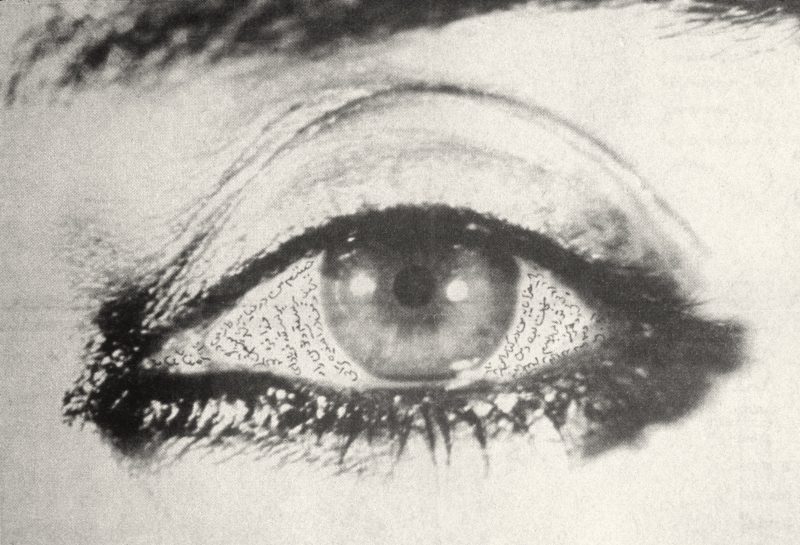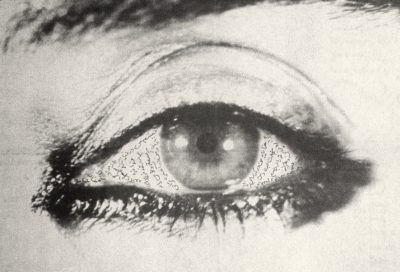Shirin Neshat es una artista visual nacida en Irán, que vive en la ciudad de Nueva York. Las series de fotos de Neshat Unveiling (1993) y Women of Allah (1993-97) examinan la feminidad en su relación con el fundamentalismo islámico y la militancia en Irán. Su trilogía de videoinstalación compuesta por Turbulent (1998), Rapture (1999) y Fervor (2000) retrata oposiciones abstractas basadas en género y sociedad. Sus videos Soliloquy (1999), Possessed (2001), Pulse (2001) y Tooba (2002) exploran la identidad femenina en el contexto de la cultura, la ley y la religión islámicas. Desde su primera exposición individual en Franklin Furnace en 1993, Neshat ha tenido exposiciones individuales en Serpentine Galleries (2000); Walker Art Center (2002); Hamburger Bahnhof (2005); Museo Stedelijk (2006); Museo del Instituto de las Artes de Detroit (2013); y Musée d’art contemporain de Montréal (2014). En 2015 se presentó una gran exposición de todos sus trabajos llamada Shirin Neshat: Facing History, presentada en el Hirshhorn Museum and Sculpture Garden. Sus premios incluyen el Golden Lion Award, el Primer Premio Internacional en la 48ª Bienal de Venecia (1999); Gran Premio de la Bienal de Gwangju (2000); Premio de Libertad de Hiroshima (2005); y Dorothy y Lillian Gish Prize (2006). Neshat está representado por Gladstone Gallery, Nueva York y Bruselas.
Shirin Neshat é uma artista visual nascida no Irã e domiciliada na cidade de Nova Iorque. A série de fotografias de Neshat entitulada Desvelando / Unveiling (1993) e Mulheres de Alá / Women of Allah (1993-97) examinam a feminilidade em relação ao fundamentalismo e à militância islâmica no Irã. A sua trilogia de instalação em vídeo, composta pelas obras Turbulência / Turbulent (1998), Arrebatamento / Rapture (1999) e Fervor (2000) retratam oposições abstratas baseadas em torno do gênero e da sociedade. As obras em vídeo de Neshat Solilóquio / Soliloquy (1999), Possuída / Possessed (2001), Pulso / Pulse (2001), e Tooba (2002) exploram a identidade feminina no contexto da cultura, lei e religião islâmica. Desde a sua primeira exibição solo no Franklin Furnace em 1993, Neshat já apresentou obras em exibições solo na Serpentine Galleries (2000); Walker Art Center (2002); Hamburger Bahnhof (2005); Stedelijk Museum (2006); Detroit Institute of Arts Museum (2013); e Musée d’art contemporain de Montréal (2014). Uma grande exibição do conjunto da obra da artista, entitulada Shirin Neshat: encarando a história / Shirin Neshat: Facing History (2015), foi apresentada no Hirshhorn Museum and Sculpture Garden. Seus prêmios incluem o Golden Lion, Primeiro Prêmio Internacional na 48a Bienal de Veneza (1999); o Grande Prêmio da Bienal de Gwangju (2000); o Prêmio Liberdade de Hiroshima (2005); e o Prêmio Dorothy and Lillian Gish (2006). Neshat é representada pela Gladstone Gallery, Nova Iorque e Bruxelas.

Photo: Marty Heitner
Unveiling (1993)
Shirin Neshat’s Unveiling (1993) explored the politics of women living behind “the veil” in Islamic countries. This multimedia exhibition featured photographs, sculptures, and films that expressed the different affective experiences of wearing the veil. Neshat integrated text into her artworks from Forough Farrokhzad (1935–1967)—an influential modern Iranian poet whose writing concerned women’s liberation and independence. As the exhibition text noted, “the artist [was] well aware of the profound complexities behind the significance of the veil within Islamic cultures and [did] not intend to deny its traditional values to many contemporary women.” Rather, Neshat was interested in exploring the question of what shapes the female experience: the veil or the body? The artist also brought into focus “the problems of transposing Western presumptions of feminist artistic expression to another culture.” Ultimately, Neshat created new understandings of the veil, while challenging stereotypes about female identity in Islam.
SHIRIN NESHAT is an Iranian-born visual artist based in New York City. Neshat’s photograph series Unveiling (1993) and Women of Allah (1993–1997) examine femininity in relation to Islamic fundamentalism and militancy in Iran. Her video installation trilogy comprising Turbulent (1998), Rapture (1999), and Fervor (2000) portray abstract oppositions based around gender and society. Neshat’s video works Soliloquy (1999), Possessed (2001), Pulse (2001), and Tooba (2002) explore female identity in the context of Islamic culture, law, and religion. Since her first solo exhibition at Franklin Furnace in 1993, Neshat has presented exhibitions at the Serpentine Galleries (2000), Walker Art Center (2002), Hamburger Bahnhof (2005), Stedelijk Museum (2006), Detroit Institute of Arts Museum (2013), and Musée d’art contemporain de Montréal (2014). A major solo exhibition of the artist’s work, Shirin Neshat: Facing History (2015), was presented at the Hirshhorn Museum and Sculpture Garden. She is the recipient of the First International Prize at the 48th Venice Biennial (1999), Grand Prix of the Gwangju Biennale (2000), Hiroshima Freedom Prize (2005), Dorothy and Lillian Gish Prize (2006), and the Silver Lion Award (2009). Neshat is represented by Gladstone Gallery, New York and Brussels.
